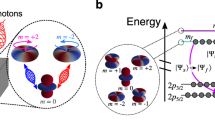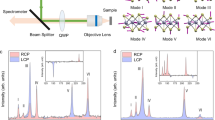Abstract
Chirality is a structural property of molecules lacking mirror symmetry that has strong implications in diverse fields, ranging from life sciences to materials science. Chirality-sensitive spectroscopic methods, such as circular dichroism, exhibit weak signal contributions on an achiral background. Helical dichroism, which is based on the orbital angular momentum (OAM) of light, offers a new approach to probe molecular chirality, but it has never been demonstrated on disordered samples. Furthermore, in the optical domain the challenge lies in the need to transfer the OAM of the photon to an electron that is localized on an ångström-size orbital. Here we overcome this challenge using hard X-rays with spiral Fresnel zone plates, which can induce an OAM. We present the helical dichroism spectra of a disordered powder sample of enantiopure salts of the molecular complex of [Fe(4,4′-diMebpy)3]2+ at the iron K edge (7.1 keV) with OAM-carrying beams. The asymmetry ratios for the helical dichroism spectra are within one to five percent for OAM beams with topological charges of one and three. These results open a new window into the studies of molecular chirality and its interaction with the OAM of light.
This is a preview of subscription content, access via your institution
Access options
Access Nature and 54 other Nature Portfolio journals
Get Nature+, our best-value online-access subscription
$29.99 / 30 days
cancel any time
Subscribe to this journal
Receive 12 print issues and online access
$209.00 per year
only $17.42 per issue
Buy this article
- Purchase on Springer Link
- Instant access to full article PDF
Prices may be subject to local taxes which are calculated during checkout





Similar content being viewed by others
Data availability
Data needed to generate Figs. 3, 4 and 5 and associated scripts are available in the Supplementary Information.
References
Barron, L. D. Symmetry and molecular chirality. Chem. Soc. Rev. 15, 189–223 (1986).
Allen, L., Beijersbergen, M. W., Spreeuw, R. J. C. & Woerdman, J. P. Orbital angular momentum of light and the transformation of Laguerre–Gaussian laser modes. Phys. Rev. A 45, 8185–8189 (1992).
Kaneyasu, T. et al. Limitations in photoionization of helium by an extreme ultraviolet optical vortex. Phys. Rev. A 95, 023413 (2017).
Forbes, K. A. & Andrews, D. L. Orbital angular momentum of twisted light: chirality and optical activity. J. Phys. Photonics 3, 022007 (2021).
Afanasev, A. et al. Experimental verification of position-dependent angular-momentum selection rules for absorption of twisted light by a bound electron. New J. Phys. 20, 023032 (2018).
Schmiegelow, C. T. et al. Transfer of optical orbital angular momentum to a bound electron. Nat. Commun. 7, 12998 (2016).
De Ninno, G. et al. Photoelectric effect with a twist. Nat. Photonics 14, 554–558 (2020).
Li, M., Yan, S., Zhang, Y., Chen, X. & Yao, B. Optical separation and discrimination of chiral particles by vector beams with orbital angular momentum. Nanoscale Adv. 3, 6897–6902 (2021).
Allen, L., Padgett, M. J. & Babiker, M. in Progress in Optics Vol. 39 (ed. Wolf, E.) 291–372 (Elsevier, 1999).
Andrews, D. L. & Babiker, M. (eds) The Angular Momentum of Light (Cambridge Univ. Press, 2012).
Forbes, K. A. & Andrews, D. L. Optical orbital angular momentum: twisted light and chirality. Opt. Lett. 43, 435–438 (2018).
Ye, L., Rouxel, J. R., Asban, S., Rösner, B. & Mukamel, S. Probing molecular chirality by orbital-angular-momentum-carrying X-ray pulses. J. Chem. Theory Comput. 15, 4180–4186 (2019).
Kerber, R. M., Fitzgerald, J. M., Oh, S. S., Reiter, D. E. & Hess, O. Orbital angular momentum dichroism in nanoantennas. Commun. Phys. 1, 87 (2018).
Brullot, W., Vanbel, M. K., Swusten, T. & Verbiest, T. Resolving enantiomers using the optical angular momentum of twisted light. Sci. Adv. 2, e1501349 (2016).
Ni, J. et al. Giant helical dichroism of single chiral nanostructures with photonic orbital angular momentum. ACS Nano 15, 2893–2900 (2021).
Rouxel, J. R., Chernyak, V. Y. & Mukamel, S. Non-local real-space analysis of chiral optical signals. Chem. Sci. 7, 6824–6831 (2016).
Varshalovich, D. A., Moskalev, A. N. & Khersonskii, V. K. Quantum Theory of Angular Momentum (World Scientific, 1988); https://doi.org/10.1142/0270
Carrascal, B., Estevez, G. A., Lee, P. & Lorenzo, V. Vector spherical harmonics and their application to classical electrodynamics. Eur. J. Phys. 12, 184–191 (1991).
Jodry, J. J., Frantz, R. & Lacour, J. Supramolecular stereocontrol of octahedral metal-centered chirality. Ligand modulation. Inorg. Chem. 43, 3329–3331 (2004).
Reddy, G. N. M., Ballesteros-Garrido, R., Lacour, J. & Caldarelli, S. Determination of labile chiral supramolecular ion pairs by chromatographic NMR spectroscopy. Angew. Chem. Int. Ed. 52, 3255–3258 (2013).
Lacour, J., Jodry, J. J., Ginglinger, C. & Torche‐Haldimann, S. Diastereoselective ion pairing of TRISPHAT anions and tris(4,4′-dimethyl-2,2′-bipyridine)iron(II). Angew. Chem. Int. Ed. 37, 2379–2380 (1998).
Sakdinawat, A. & Liu, Y. Soft-x-ray microscopy using spiral zone plates. Opt. Lett. 32, 2635–2637 (2007).
Kohmura, Y. et al. Nano-structuring of multi-layer material by single x-ray vortex pulse with femtosecond duration. Appl. Phys. Lett. 112, 123103 (2018).
Vila-Comamala, J., Sakdinawat, A. & Guizar-Sicairos, M. Characterization of x-ray phase vortices by ptychographic coherent diffractive imaging. Opt. Lett. 39, 5281–5284 (2014).
Odstrcil, M., Lebugle, M., Lachat, T., Raabe, J. & Holler, M. Fast positioning for X-ray scanning microscopy by a combined motion of sample and beam-defining optics. J. Synchrotron Radiat. 26, 504–509 (2019).
Faulkner, H. M. L. & Rodenburg, J. M. Movable aperture lensless transmission microscopy: a novel phase retrieval algorithm. Phys. Rev. Lett. 93, 023903 (2004).
Zhang, B. & Zhao, D. Focusing properties of Fresnel zone plates with spiral phase. Opt. Express 18, 12818–12823 (2010).
Rösner, B. et al. High resolution beam profiling of X-ray free electron laser radiation by polymer imprint development. Opt. Express 25, 30686–30695 (2017).
Rebernik Ribič, P. et al. Extreme-ultraviolet vortices from a free-electron laser. Phys. Rev. X 7, 031036 (2017).
Ricci, F. et al. Instability of higher-order optical vortices analyzed with a multi-pinhole interferometer. Opt. Express 20, 22961–22975 (2012).
Gawelda, W. et al. Structural determination of a short-lived excited iron(II) complex by picosecond x-ray absorption spectroscopy. Phys. Rev. Lett. 98, 057401 (2007).
Lima, F. A. et al. A high-repetition rate scheme for synchrotron-based picosecond laser pump/x-ray probe experiments on chemical and biological systems in solution. Rev. Sci. Instrum. 82, 063111 (2011).
Penfold, T. J. et al. X-ray spectroscopic study of solvent effects on the ferrous and ferric hexacyanide anions. J. Phys. Chem. A 118, 9411–9418 (2014).
Peacock, R. D. & Stewart, B. Natural circular dichroism in X-ray spectroscopy. J. Phys. Chem. B 105, 351–360 (2001).
Alagna, L. et al. X-ray natural circular dichroism. Phys. Rev. Lett. 80, 4799–4802 (1998).
Carra, P. & Benoist, R. X-ray natural dichroism. Phys. Rev. B 62, R7703–R7706 (2000).
Goulon, J. et al. X-ray natural circular dichroism in a uniaxial gyrotropic single crystal of LiIO3. J. Chem. Phys. 108, 6394–6403 (1998).
Turchini, S. et al. Core electron transitions as a probe for molecular chirality: natural circular dichroism at the carbon K-edge of methyloxirane. J. Am. Chem. Soc. 126, 4532–4533 (2004).
Villaume, S. & Norman, P. On circular dichroism and the separation between chromophore and chiral center: the near carbon K-edge X-ray absorption and circular dichroism spectra of noradrenaline and L-DOPA. Chirality 21, E13–E19 (2009).
Forbes, K. A. & Garth, A. J. Optical vortex dichroism in chiral particles. Phys. Rev. A 103, 053515 (2021).
Gatti, G. et al. Radial spin texture of the Weyl fermions in chiral tellurium. Phys. Rev. Lett. 125, 216402 (2020).
van Veenendaal, M. Interaction between x-ray and magnetic vortices. Phys. Rev. B 92, 245116 (2015).
Chergui, M. Picosecond and femtosecond X-ray absorption spectroscopy of molecular systems. Acta Crystallogr. A 66, 229–239 (2010).
Chergui, M. & Collet, E. Photoinduced structural dynamics of molecular systems mapped by time-resolved X-ray methods. Chem. Rev. 117, 11025–11065 (2017).
Oppermann, M., Zinna, F., Lacour, J. & Chergui, M. Chiral control of spin-crossover dynamics in Fe(II) complexes. Nat. Chem. https://doi.org/10.1038/s41557-022-00933-0 (2022).
Rouxel, J. R., Kowalewski, M. & Mukamel, S. Photoinduced molecular chirality probed by ultrafast resonant X-ray spectroscopy. Struct. Dyn. 4, 044006 (2017).
Bahrdt, J. et al. First observation of photons carrying orbital angular momentum in undulator radiation. Phys. Rev. Lett. 111, 034801 (2013).
Hemsing, E., Dunning, M., Hast, C., Raubenheimer, T. & Xiang, D. First characterization of coherent optical vortices from harmonic undulator radiation. Phys. Rev. Lett. 113, 134803 (2014).
Acknowledgements
This work was supported by the European Research Council Advanced Grants H2020 ERCEA 695197 DYNAMOX, the Swiss NSF via the NCCR:MUST and grants 200020_169914 and 200021_175649. D.K. acknowledges funding from SNSF under grant no. 200021_175905. J.R.R. was supported by the Fédération André Marie Ampère (FRAMA) and the LABEX MANUTECH-SISE (ANR-10-LABX-0075) of the Université de Lyon, within the program ‘Investissements d’Avenir’ (ANR-11-IDEX-0007) operated by the French National Research Agency (ANR). C.B. and G.F.M. were supported via the InterMUST Women Fellowship. G.F.M. acknowledges the support of the European Union’s Horizon 2020 research and innovation programme (grant agreement no. 851154). F.Z. and J.L. thank the University of Geneva and the Swiss NSF for support via grant 200020-184843.
Author information
Authors and Affiliations
Contributions
J.R.R., B.R., D. Karpov and M.C. conceived and organized the experiments. J.R.R., B.R., D. Karpov, C.B., G.F.M., D. Kinschel, O.C., C.S. and A.D. carried out the experiments. B.R. and C.D. designed and fabricated the spiral Fresnel zone plates. F.Z. and J.L. synthesized the chiral salts. M.O. characterized the samples and provided critical feedback. J.R.R., B.R. and M.C. interpreted the results and wrote the manuscript with contributions from all authors.
Corresponding authors
Ethics declarations
Competing interests
The authors declare no competing interests.
Peer review
Peer review information
Nature Photonics thanks Jianhui Chen, Olga Smirnova and the other, anonymous, reviewer(s) for their contribution to the peer review of this work.
Additional information
Publisher’s note Springer Nature remains neutral with regard to jurisdictional claims in published maps and institutional affiliations.
Supplementary information
Supplementary Information
Supplementary Figs. 1–7 and discussion.
Rights and permissions
About this article
Cite this article
Rouxel, J.R., Rösner, B., Karpov, D. et al. Hard X-ray helical dichroism of disordered molecular media. Nat. Photon. 16, 570–574 (2022). https://doi.org/10.1038/s41566-022-01022-x
Received:
Accepted:
Published:
Issue Date:
DOI: https://doi.org/10.1038/s41566-022-01022-x
This article is cited by
-
Intrinsic dichroism in amorphous and crystalline solids with helical light
Nature Communications (2024)
-
Optical spatiotemporal vortices
eLight (2023)
-
Progress and prospects in nonlinear extreme-ultraviolet and X-ray optics and spectroscopy
Nature Reviews Physics (2023)



